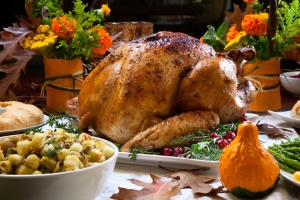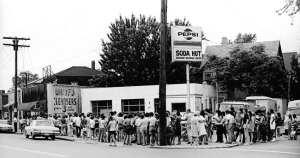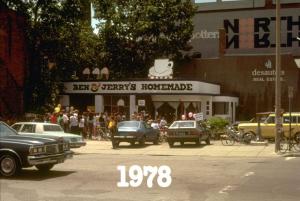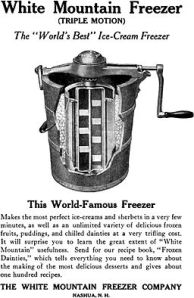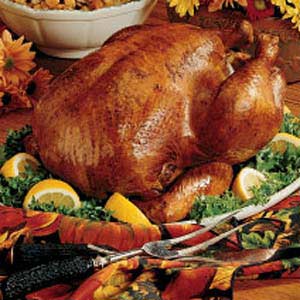
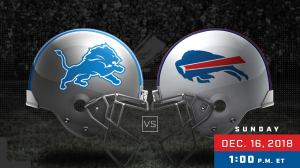
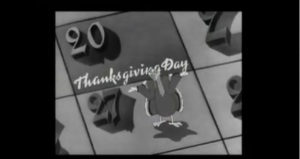

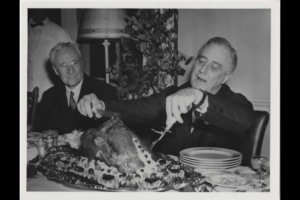
Most of my Thanksgiving celebrations have been in Canada, but twice in the 1980s I found myself living in the United States for Thanksgiving on Thursdays. I was living in West Somerville, Massachusetts (home of the now gone but never forgotten legendary Steve’s Ice Cream, started by Steve Herrell on Elm Street in Davis Square, where the ice cream was hand-stirred in the front window in a Nashua, New Hampshire-made four-and-a-half gallon Triple Motion dasher White Mountain rock-salt and ice freezer) in 1980, and in 1989, in East Durham, North Carolina.
Midday meant the traditional Thanksgiving Thursday Detroit Lions NFL football game classic. The Detroit Heralds started the tradition in 1917 when they played against the Canton Bulldogs in a 7-0 loss. The Heralds played again in 1920. then the short-lived Detroit Tigers football team played the Chicago Staleys in 1921. The Detroit Panthers played in 1925 and 1926, and the Detroit Wolverines played in 1928. Thanksgiving football in Detroit has been happening for more than a century. Detroit held its first such matchup against the Chicago Bears in 1934 and has played on the holiday every year since 1945.
In the 1980 game, the Chicago Bears beat the Detroit Lions 23-17.
My New England turkey came from Star Market in Porter Square, I believe, in adjacent Cambridge, although the exact geography is a bit fuzzy after 42 years, while I believe Food Lion was my likely turkey supplier of choice in North Carolina at the other end of the decade in 1989. In New England, Star Market was something of a grocery story chain legend (New England has a lot legends). Started by Stephen P. Mugar in 1915, Star Market by 1980 was owned by Jewel-Osco, another supermarket chain headquartered in Itasca, Illinois, a Chicago suburb. The Star Market I shopped at in Cambridge, I believe, was in a kind of redlined area for grocery stores, so neighbourhood supermarkets were few and far between.
Food Lion for its part had begun in 1957 as a one-store operation in Salisbury, North Carolina, under the name Food Town and was founded by Ralph W. Ketner.
Originally, the Pilgrim Puritans of Massachusetts Bay Colony celebrated their first Thanksgiving Day on July 8, 1629. The following year, John Winthrop gave his famous sermon, “A Model of Christian Charity,” where he rightly predicted the colony would be metaphorically, as from salt and light in Jesus’ Sermon on the Mount, as recorded in the Gospel of Matthew, known as the “city on a hill, ” watched by the world.
“For we must consider that we shall be as a city upon a hill,” Winthrop said. “The eyes of all people are upon us … we must be willing to abridge ourselves of our superfluities, for the supply of others’ necessities. We must uphold a familiar commerce together in all meekness, gentleness, patience, and liberality. We must delight in each other; make others’ conditions our own; rejoice together, mourn together, labor and suffer together, always having before our eyes our commission and community in the work, as members of the same body.”
Almost four centuries later, their purposes perhaps not quite as lofty, Americans now celebrate Thanksgiving on the fourth Thursday of November. It is the single-biggest domestic travel weekend of the year for Americans going home, wherever that might be, to visit family. While technically speaking, American Thanksgiving is a one-day holiday, like here in Canada, except on a Thursday instead of a Monday, for all intents and purposes it is part of a very long weekend (officially the Wednesday and Friday are not holidays in the United States, just the Thursday, but virtually no one – aside from unfortunate retail store clerks – works the Friday, as those of us who have lived there know.) Just try and get a government official on the telephone after mid-afternoon Wednesday, or all day Friday of American Thanksgiving week if you wish to test this hypothesis.
While the fourth Thursday in November is also often the last Thursday as well (as it is this year), even a cursory glance through the years of our Gregorian calendar reveal some years, of course, have five Thursdays. Such was the case in 1939, the last year of the Great Depression, when Thanksgiving was scheduled to fall on Nov. 30, not only on the fifth Thursday of November but the very last day of November as well in fact, and less than a month before Christmas, causing President Franklin D. Roosevelt, a Democrat, to use the moral authority of his office by proclamation to move Thanksgiving up a week to Nov. 23 at the initiative of Lew Hahn, general manager of the Retail Dry Goods Association, who had warned U.S. Secretary of Commerce Harry Hopkins as early as August that the late calendar date of Thanksgiving that year could have an adverse effect on retail sales, and that an earlier Thanksgiving could perhaps boost the bottom line.
To understand the rationale more fully, harken back to that bygone era where it was quaintly considered bad form for retailers to display Christmas decorations or have Christmas sales before the celebration of Thanksgiving, as opposed to the current day-after Halloween kick-off. Or is it the day after Labor Day now Christmas sales start? One of the two methinks.
Roosevelt, however, had waited until Oct. 31 to announce his thinking on the matter of moving up Thanksgiving by a week 23 days later. The short-notice change in dates affected the holiday plans of millions of Americans; while there was plenty of confusion and many were inconvenienced, others hit pay dirt.
On the downside, many college football teams traditionally ended their seasons with games against their main rivals on Thanksgiving, and had scheduled them in 1939 for Nov. 30. Some athletic conferences had rules permitting games only through the Saturday following Thanksgiving. Changing the date could mean many teams would play their season finale in empty stadiums or not at all. The change also reportedly caused problems for college registrars, schedulers and calendar makers.
The Thanksgiving winners in 1939 lived in Colorado, Mississippi and Texas. Those three states observed two Thanksgiving holidays that year; the just-proposed Thursday, Nov. 23, and then they did it all over again a week later on the originally scheduled holiday on Thursday, Nov. 30.
Now, that’s something to express gratitude for, unless your were a turkey taking a double-hit on your numbers possibly in Colorado, Mississippi and Texas. All told, 23 states and the District of Columbia, of the 48 states in those pre-statehood days for Alaska and Hawaii (both joined the union 20 years later in 1959), recognized Nov. 23 as Thanksgiving in 1939, while 22 states stuck with the original Nov. 30 date as planned.
Gradually, the fourth Thursday in November as Thanksgiving, with some see-sawing back-and-forth and general waffling, took a more permanent hold throughout the United States. Texas was the last state to change its holiday law, observing the last Thursday in November as Thanksgiving when there are five Thursdays in the month for the final time on Thursday, Nov. 29, 1956.
The considerable, and for a time in the early 1940s, still ongoing confusion surrounding when Thanksgiving should be celebrated was not surprisingly diffused in the popular culture as ripe material for laughs through cinema, as well as radio. “In the 1940 Warner Bros. Merrie Melodies cartoon Holiday Highlights, directed by Tex Avery,” Wikipedia notes, “the introduction to a segment about Thanksgiving shows the holiday falling on two different dates, one ‘for Democrats’ and one a week later ‘for Republicans.’”
In the 1942 musical Holiday Inn, starring Bing Crosby and Fred Astaire, a classic black-and-white film, which I borrowed in DVD format from the Thompson Public Library a few years ago, there is a delightful parody where a November calendar appears on which an animated turkey jumps back and forth between the two weeks, until he gives up and shrugs his shoulders at the audience.
And speaking of turkeys getting the last laugh, no discussion of American Thanksgiving is complete, of course, without addressing the issue of the Presidential turkey pardon.
President Joe Biden pardoned two turkeys, Chocolate and Chip, on Monday as he discharged the presidential duty of the annual Thanksgiving turkey pardon.
“The votes are in, they’ve been counted and verified, no ballot stuffing, no fowl play. The only red wave this season is going to be if German Shepherd Commander knocks over the cranberry sauce,” Biden told an audience on the White House South Lawn.
President Abraham Lincoln’s 1863 clemency to a turkey recorded in an 1865 dispatch by White House reporter Noah Brooks was the origin for the pardoning ceremony, according to the White House Historical Association, a private, nonprofit organization founded in 1961 by First Lady Jacqueline Kennedy with a mission to protect, preserve, and provide public access to the rich history of America’s Executive Mansion.
Reports of turkeys as gifts to American presidents can be traced to the 1870s, when Rhode Island poultry dealer Horace Vose began sending well fed birds to the White House. The First Families did not always feast upon Vose’s turkeys, but the yearly offering gained his farm widespread publicity and became a veritable institution at the White House. At Thanksgiving 1913, a turkey-come-lately from Kentucky shared a few minutes of fame with the fine-feathered Rhode Islander. Soon after, in December, Horace Vose died, thus ending an era.
By 1914, the opportunity to give a turkey to a president was open to everyone, and poultry gifts were frequently touched with patriotism, partisanship, and glee. In 1921, an American Legion post furnished bunting for the crate of a gobbler en route from Mississippi to Washington, while a Harding Girls Club in Chicago outfitted a turkey as a flying ace, complete with goggles. First Lady Grace Coolidge accepted a turkey from a Vermont Girl Scout in 1925. The turkey gifts had become established as a national symbol of good cheer.
With animal rights activists picketing nearby, President George H.W. Bush quipped “‘Reprieve,’ ‘keep him going,’ or ‘pardon’: it’s all the same for the turkey, as long as he doesn’t end up on the president’s holiday table.”
Recently, White House mythmakers have claimed that President Harry S. Truman began the tradition of “pardoning” a turkey. However, the Truman Library & Museum disputes the notion that he was the first to do so. The focus on Truman stems from his being the first president to receive a turkey from the Poultry and Egg National Board and the National Turkey Federation. From September to November 1947, announcements of the government encouraging “poultryless Thursdays” grabbed national headlines. Outrage from homemakers, restaurant owners, and the poultry industry was palpable in Washington. This came to a head when the poultry industry pointed out that the upcoming Thanksgiving, Christmas, and New Year’s Day, the three big turkey holidays, happened to fall on Thursday. The effort was deflated in time for Thanksgiving, but not before poultry growers had sent crates of live chickens— “Hens for Harry”— to the White House in protest. The turkey they presented to President Truman that December promoted the poultry industry and established an annual news niche that endures today.
While 1947 was the beginning of the official turkey presentation from the poultry industry, the turkey pardon remained a sporadic tradition. In December 1948, Truman accepted two turkeys and remarked that they would “come in handy” for Christmas dinner. There was clearly no plan for these birds to receive a presidential pardon. The Washington Post used both “pardon” and “reprieve” in a 1963 article in which President Kennedy said of the turkey, “Let’s keep him going.” During the latter years of the Nixon presidency, Patricia Nixon accepted the turkeys on behalf of the President and in 1973 sent the bird to the Oxon Hill Children’s Farm.
A piece called “Why presidents pardon turkeys — a history” by Domenico Montanaro, PBS Newshour in November 2014 also offered a comprehensive history of the practice, which you can read at http://www.pbs.org/newshour/updates/presidents-pardon-turkeys-history/#.VHbAtv1lVLA.facebook
You can also follow me on Twitter at:https://twitter.com/jwbarker22

